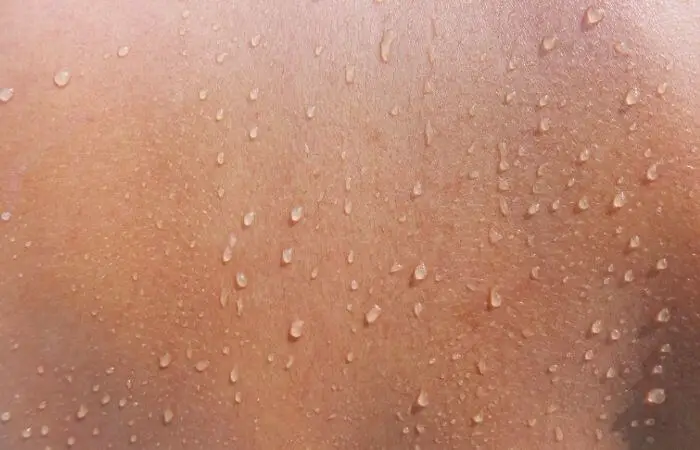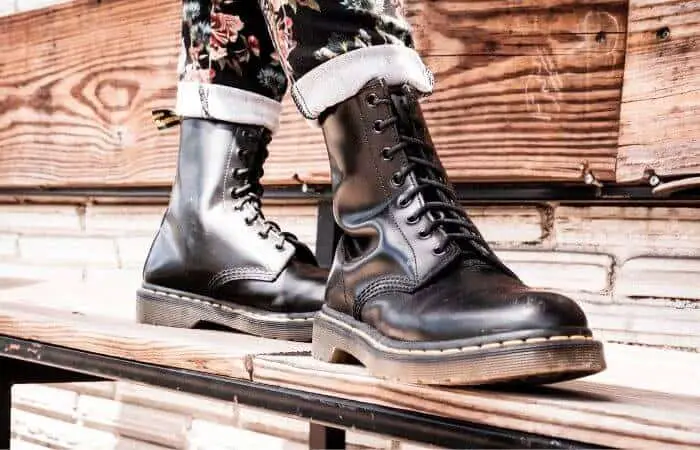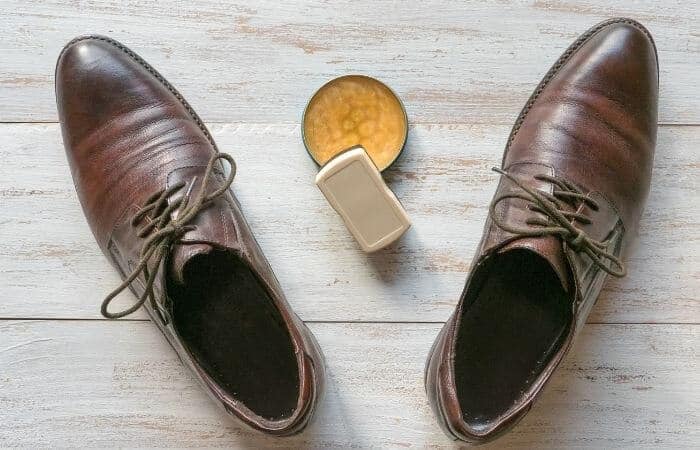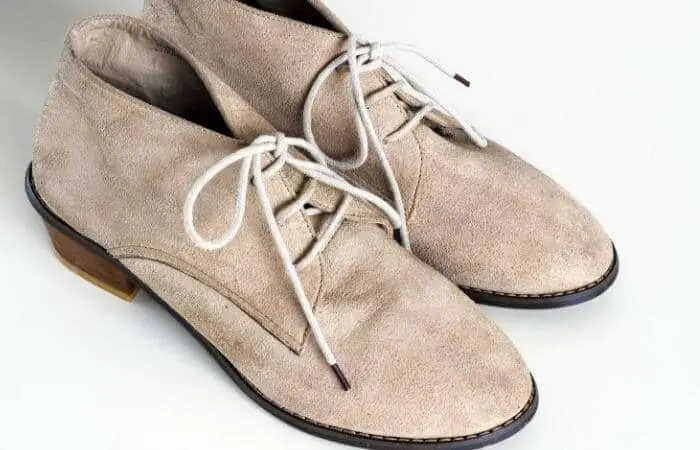The short answer is that leather is not waterproof, but it can be made more water repellent and is often sold as water-resistant.
However, your leather will often become less water resistant with age.
The speed at which it becomes less water resistant depends on how you care for and treat your leather.
Leather is Skin and Skin is Waterproof

If it were not, then all the fluid in your body would seep out like the moisture dripping out from a hanging sponge.
There is a little confusion as to if skin is waterproof because we have all been in the bath and seen our fingertips wrinkle because of the water our skin has absorbed.
Yet, in reality, your skin is quite waterproof.
It is just that certain outer and inner layers are slightly permeable, which means they allow water/fluid to soak in a little.
There is a layer of reactive fat cells that work between the layers of your skin.
This same fatty-alive substance is what makes most mammals’ skin waterproof.
Without getting too technical, the layer of living fat in your body is able to open and close at will, allowing it to keep water inside your body.
This same fatty-alive substance allows your skin to seep water and fluid out at will.
This same layer of fat stops working when you die, which is why bodily fluids seep from everywhere once you (or any mammal) is dead.
So, for example, even if you were to take every part of a cow’s skin, hang it and somehow tan it to make leather, even if the tanned leather still contained that special fatty tissue, it wouldn’t be waterproof because the fatty substance has to be alive for skin to be waterproof.

Leather is Skin, Yet Is Not Waterproof
The fact that leather (tanned skin) is not waterproof may come as a shock to you, especially since most of the leather items you buy are water-resistant.
For example, people buy leather couches because they are easy to clean, and people buy leather shoes that are waterproof and leather jackets that are waterproof.
New leather is somewhat water-resistant. New and untreated leather will happily endure light sprinkles of water, light rain showers, moist conditions and so forth.
Older leather will not fare as well, but new leather can withstand a moderate amount of water.
Since leather is made from skin, untreated leather is only slightly water-resistant.
A Leather Cat Suit and The Ocean
Imagine a Bond woman walking out of the ocean covered in a neck-to-ankle catsuit made of treated leather.

One would imagine that her body would be fairly dry, the same as if she had a rubber diving suit on.
However, her skin would actually be slightly moist if she were wearing a leather catsuit.
When you wear a wet suit for diving, you come out of the water and your skin is a little moist because you have sweated into it.
The seawater has not seeped in, but you have sweated and the sweat couldn’t escape the suit.
However, the leather-clad Bond girl would be damp from sweat and damp from the seawater that had soaked through.
As a result, the Bond woman would also be significantly colder than somebody who was wearing a rubber diving suit.
Why Is the Bond Girl Wet?
The ocean-going Bond woman would be wet through sweat and would be wet through the imperfections in the leather.
In some cases, the less sturdy parts of the leather may allow water in.
Plus, all the zips and holes made from the stitching would also cause water to seep in (though there are ways that you can waterproof zippers).
Plus, you have to remember that untreated leather is permeable, and even treated leather is still slightly permeable.
The leather allows water in, and untreated leather lets water seep through more quickly.
Leather Isn’t Easy to Make 100% Waterproof
Commonly, people say that leather can “Never” be made fully waterproof, but this is not completely true.
For example, if you were to glue a piece of leather to a wooden board, then nail the leather onto the post, and then coat it with several layers of varnish, then the leather would be 100% waterproof for a very long time.
However, in reality, making leather 100% waterproof and still usable is very difficult.
Even if you were to coat the leather in a very powerful substance that makes it waterproof, the waterproofing would degrade over time, and so would the leather because the leather is in use.
Ever notice how the elbows of old jackets seem to degrade first.
This is because they are the part of the jacket that moves the most often.
The chemical treatment that the coat enjoyed is rubbed, knocked, and worn off the elbows more quickly.
Plus, the expanding and stretching from moving one’s arms also degrades the leather so that the elbows often look the worst on older jackets.
…But My Leather Shoes Are Waterproof

Actually, your leather doc martens are not waterproof.
If they are new, if they are chemically treated, if they are of a high quality, and if you look after them (care for them) very well, then your leather shoes are “Highly water-resistant.”
They may even be water repellent, but they are not waterproof.
Want to test to see if your shoes are waterproof?
You would have to stand in a puddle so the water rests lower than the tongue-hole or lace holes, but higher than the sole of the shoe.
You would have to stand there for an hour.
After the hour, test to see if your foot is wet.
In this scenario, after an hour, even a brilliantly-made leather shoe would start letting in water.
For something to be waterproof, it has to keep water out of the interior, and leather is unable to do that.
Water is slowly absorbed over time, and in many cases, the water is absorbed fairly quickly (albeit doing little-to-no damage).
Plus, watermarks can sometimes look ugly on an otherwise pristine pair of shoes.
As a side note, chemical treatments and various types of waxes enable you to waterproof your leather to a certain extent.
And, where things like chemical cleaners will cause damage, one of the most obvious causes of damage is alcohol.
If you have ever worked behind a bar in leather shoes, you will know the sort of damage that even a weak beer can cause on your shoes.
Alcohol is one of the worst over-the-counter/household chemicals your leather shoes can be exposed to for extended periods.
Oils, Conditioners and Waxes
When you care for and treat your leather, you are not just doing it to make the leather more water-resistant.

You are also extending the life of your leather.
If you are committed to keeping your leather as water-resistant as possible and keeping your leather as pristine as possible, then you really need to follow the rules on the conditioner, mink oils or wax container.
For example, if you are applying a wax, it is very important that you spread it as thinly and as evenly as possible.
Applying the wax incorrectly can do more damage than good over the long term.
The same is true for conditioners.
If your leather is becoming dry and cracking, then it is becoming more and more permeable.
You will have to do a little conditioning to help maintain the leather’s strength and water resistance.
Again, you will need to follow the instructions to the letter because in this case, the leather needs to be wet before the conditioner is applied so that the conditioner can sink in and do its job correctly.
A Permeable Organic Substance
Leather is not waterproof in the same way as skin is because the fatty-alive layer that makes skin water-resistant is absent from leather, and because the fatty layer that keeps skin waterproof also needs to be alive in order to work.
When you apply chemicals to leather, it is a little like covering yourself in suntan lotion.
You get a temporary amount of protection, but eventually, the water will get to your skin as the lotion wears off, or as you become submerged in water.
New leather starts out fairly water-resistant, but as it ages it dries out and loses its flexibility, stretchiness and strength.
However, even new leather cannot stand being completely submerged in water.
If this occurs, the leather takes a great deal of damage when it is dried.
Plus, your leather will probably have to endure various types of bacteria and rot that will cause it damage over time.
Also Read: Is Wool Waterproof?
The Least Water-Resistant Leather
The most permeable, non-waterproof leather, is suede leather.

The regular leather you see on couches, jackets and shoes is made from the harder-wearing external skin layer.
Suede is made from the underside of the skin.
As you know, suede is easily scratched, stained, discolored, and is also far less water-resistant.
Part of the reason your suede shoes are less water-resistant is that manufacturers are less likely to pile chemicals on your suede shoes.
They will happily treat and re-treat your regular leather shoes but chemically-overworked suede looks bad.
In many cases, it has a light layer of sprayed waterproofing applied before it leaves the factory.
People who are fans of suede may also re-waterproof their suede using over-the-counter waterproofing sprays that are made for the job.
Yet, even these sprays will not help you maintain the quality of your suede if it is stored incorrectly.
For example, if you store your suede shoes in a muggy bathroom or humid shed, then your suede will degrade rather quickly.
The best choice to waterproof suede boots or shoes is to use a high-quality wax such as Otterswax.
Suede may seem like more hassle than it is worth when it comes to leather goods, but some people consider suede to be the best looking and best feeling type of leather, so they endure the misery of their leather maintenance.

